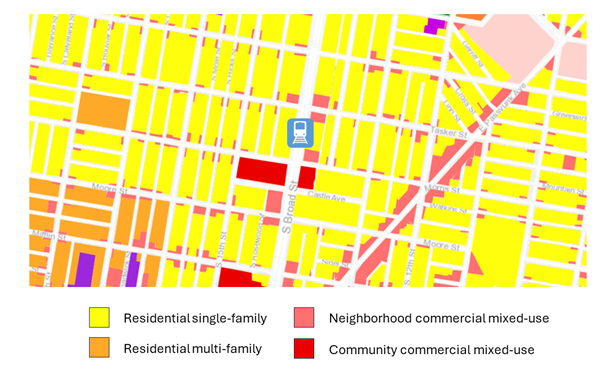Data from the National Renewable Energy Laboratory show that low-income Philadelphia residents can’t reach as many jobs by transit as the general population. In Milwaukee, a bus network redesign and faster bus service has likely made it easier for residents to get to work.
Transportation is the largest source of greenhouse gas (GHG) emissions in the United States, and personal vehicles make up 58% of all transportation emissions. One strategy for tackling emissions from these vehicles is making it easier to reach key destinations without a car.
The Mobility Energy Productivity (MEP) tool, developed by the National Renewable Energy Laboratory (NREL) with funding from the Energy Efficient Mobility Systems (EEMS) program of the U.S. Department of Energy, measures how well residents can reach destinations in a convenient, cost-effective, and energy-efficient way. The tool overlays a city map with a grid divided into one square kilometer units and measures how many opportunities (including jobs, educational opportunities, healthcare facilities, and others) can be reached from within each unit by different modes of travel. NREL provided ACEEE with data on the efficiency of different travel modes for the 75 cities featured in the recently released 2024 City Clean Energy Scorecard. We looked at two of these cities to understand how the data can be used to explore changes in transportation access over time and among certain populations.
We found that in Philadelphia, based on 2023 data, low- to moderate-income (LMI) residents (defined as someone in a household earning less than 80% of the area median income) have access to 16% fewer jobs within 20 minutes by public transit on average compared to the general population. Several factors likely contribute to this, including low residential density in neighborhoods served by transit and a lower number of LMI residents in or near the downtown area, which has a high concentration of jobs. For Milwaukee, we examined the change in transit access over time. Between 2019 and 2023, the city saw an increase of 32% in the number of jobs accessible by transit within 30 minutes. This increase coincided with a bus network redesign and the launch of the city’s first bus rapid transit route.
In some cities, low-income residents have access to fewer jobs
Ensuring that low-income communities have access to affordable, high-quality transit can support economic mobility, especially for the 10.4 million American households without a car. Unfortunately, in some cities, residents in LMI households have access to fewer jobs on average than the general population.
As the maps derived from the MEP tool below show, neighborhoods like Lower Moyamensing (about three miles from downtown in South Philadelphia) have higher numbers of LMI residents and access to fewer jobs by transit. This lower access is likely due to the limited number of transit routes within walking distance of residents that directly connect these neighborhoods to downtown jobs. Though riders can reach more jobs with transfers along their route, this typically extends the trip length beyond 20 minutes.
Number of Philadelphia residents with household incomes below 80% of the area median income in a given area (left) and number of jobs accessible by transit within 20 minutes from a given area (right). The angled squares (in black on the left and yellow on the right) indicate the Lower Moyamensing neighborhood. Source: NREL’s MEP tool.
One strategy that cities like Philadelphia can employ to support better access for low-income populations is revising their zoning codes to allow greater residential density near high-frequency transit. Residents of South Philadelphia can take a heavy rail line called the Broad Street Line to the downtown area. However, south of Washington Avenue, much of the land within a fourth of a mile of the Broad Street Line is zoned for single-family housing. This means that relatively few households can live near this high-frequency transportation service. By allowing higher-density residential development near transit and incentivizing affordable housing within such developments, cities can help LMI residents live closer to transit and access more jobs in a shorter commute time.
Most of the land around the Broad Street Line’s Tasker-Morris station is zoned for single-family housing (bright yellow). Source: City of Philadelphia’s OpenMaps.
Improved transit service can connect people to jobs
In many cities, due in part to service cuts resulting from the COVID-19 pandemic, the number of jobs that can be accessed by transit has declined since 2019. However, some cities, like Milwaukee, have seen the opposite, according to MEP data. In 2019, the average Milwaukee resident could reach approximately 50,000 jobs within 30 minutes by transit. In 2023, that number was over 66,000, a 32% increase. While it’s difficult to identify every factor contributing to this change, a few events stand out.
Number of jobs accessible by transit within 30 minutes in 2019 (left) and 2023 (right). Source: NREL’s MEP tool.
In 2021, the Milwaukee County Transit System completed a bus network redesign to improve travel times and expand access to certain areas. The redesign added six new high-frequency routes, which arrive every 15 minutes on weekdays, bringing the proportion of high-frequency routes from 40% of all routes to 60%. Some existing routes were also adjusted, with new routing along major corridors or the removal of underutilized stops. Faster travel times and more frequent service meant that more jobs became accessible within a shorter commute time.
Also in 2021, Milwaukee County Transit System (MCTS) launched its first bus rapid transit route, MCTS CONNECT. Bus rapid transit is a form of bus transportation that offers faster and higher-frequency service compared to standard bus service. MCTS CONNECT takes advantage of dedicated lanes to minimize delays from traffic, elevated stations to facilitate boarding by riders in wheelchairs, and other tools to efficiently transport passengers.
While other factors likely contributed to the increase in jobs accessible by transit, network redesigns and service expansions like Milwaukee’s can make a noticeable difference for residents not currently living near high-frequency public transit.
A holistic picture goes beyond access to jobs
Many existing metrics quantify access to opportunities with travel time as the primary weighting factor but ignore other externalities, such as the energy consumption and cost of using a particular mode. NREL’s MEP tool, the source of the transit travel time and population data we reference for Milwaukee and Philadelphia, was developed to address this need. ACEEE plans to incorporate MEP data into the metrics of the next edition of City Scorecard, with the goal of evaluating cities’ progress on equitably advancing efficient transportation options.
While access to jobs is an important metric for capturing the efficiency of a city’s transportation system, access to other services and destinations can be just as critical. The MEP tool can demonstrate residents’ ability to access health care, education, food, recreation, and shopping in addition to jobs. Convenient, affordable, and energy-efficient access to all of these opportunities is vital to a thriving community.






